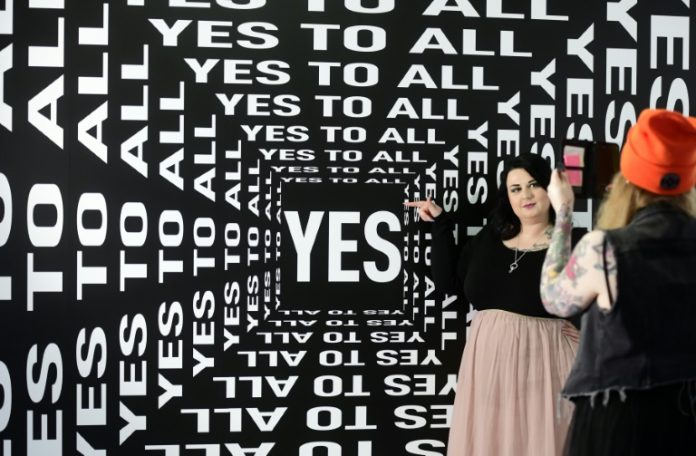Crammed into a supermarket trolley, Kiki Malliora squealed with laughter as she rolled past her sister at Cologne’s pop-up selfie museum, where visitors said having fun outweighs the hunt for “likes” in a changing social media landscape.
“Sure, the setting is fake,” said the 38-year-old office administrator, dressed in a black crop t-shirt and jeans.
“But what matters to me is that the picture is real and that people can see I’m having a good time.”
With its bubblegum-pink balloons, neon-coloured ball pits and retro American diner as eye-popping, readymade photographic backdrops, the Supercandy Museum is an Instagrammer’s dream.

But the attraction’s three-month run comes as a new wave of social media users prize authenticity over staged photos, and celebrity influencers are increasingly honest about the effort that goes into keeping up a picture-perfect feed.
US singer Demi Lovato attracted almost 10 million Instagram “likes” when she posted an unedited bikini shot revealing her cellulite, while Hollywood actress Drew Barrymore showed herself crying on a “difficult and not so pretty” day.
Instagram is even experimenting with making the “like”-button invisible in response to concerns over its mental health impact.
Critics say younger users especially report feeling anxious or self-conscious if their posts don’t perform well.
“When I see those elaborately staged pictures, I just think: God, that must have taken a lot of work,” said Malliora.
Her younger sister Nathalie, who keeps her Instagram account private for pre-approved followers only to see any uploaded photos and videos she shares, nodded in agreement.

Pop-up attractions like the one in Cologne have sprung up across the globe in recent years, offering anyone armed with a smartphone a plethora of brashly coloured, playful settings to liven up their social media presence.
The Supercandy Museum returned to the western German city this month after a previous six-month stint drew over 42,000 mainly female visitors, with full-price tickets costing 29 euros ($32).

The man behind Supercandy, Frank Karch, said ticket sales were “noticeably up” for the second edition, this time located in an industrial building in the city’s hip Ehrenfeld district.
“Eventually this craze too will run its course,” he told media.
But the emergence of creators championing unfiltered, real-life pictures isn’t a threat to his business model, he said, arguing that social media was diversifying so much there was a niche for everyone.
“The overarching mega-trend will stay the same it has been since the invention of painting: wanting to have a nice picture of yourself,” he said.
Social media expert Klemens Skibicki, a professor at the Cologne Business School, agreed but said the gulf was widening between those who see social media as a hobby, and those who use it as a tool to promote themselves or a brand – with some influencers earning enough to quit their day jobs.
Eschewing “selfies”, which anyone can take, influencers tend to opt more for “posies” taken by someone else, often a professional photographer, he said, to keep their posts looking polished and aspirational.

At Supercandy, German reality TV couple Ginger Costello Wollersheim and Bert Wollersheim — who have 85,000 followers between them – played with piles of pink $100 bills as their photographer snapped away.
“If you don’t post good pictures for a while, you get fewer likes and people unfollow. So we’re here to make beautiful, creative photos,” said Ginger, 33, smiling broadly.
Her long-haired husband Bert, a regular feature in Germany’s tabloid press, said they weren’t “fanatical” about chasing “likes”.

“Coming here is fun, it changes our story up a bit and that’s good for us professionally,” added the 68-year-old, clad in shades and sparkly trainers.
But not everyone could see the appeal of what is essentially a giant photo studio.
Chatting with her friends in a busy Cologne shopping street, high school student Anna-Maria cringed at the thought of forking out money to pose against an artificial backdrop.
“That’s way too fake. I prefer spontaneous snapshots, where someone is laughing or in the middle of doing something,” the 17-year-old said.
“And I’d only post a selfie if my friends were in it too.”












